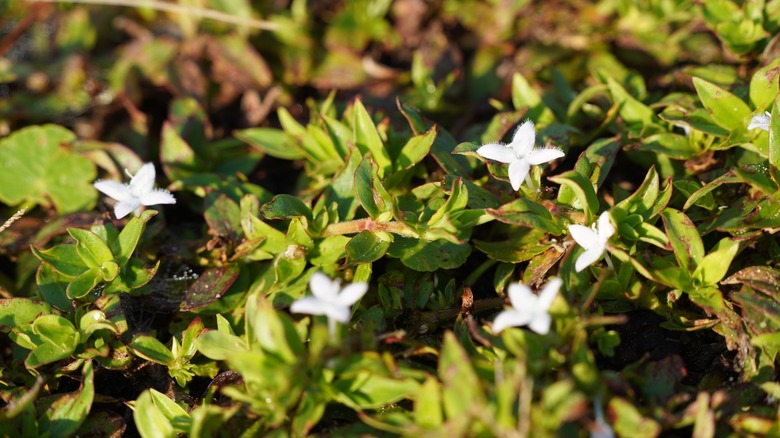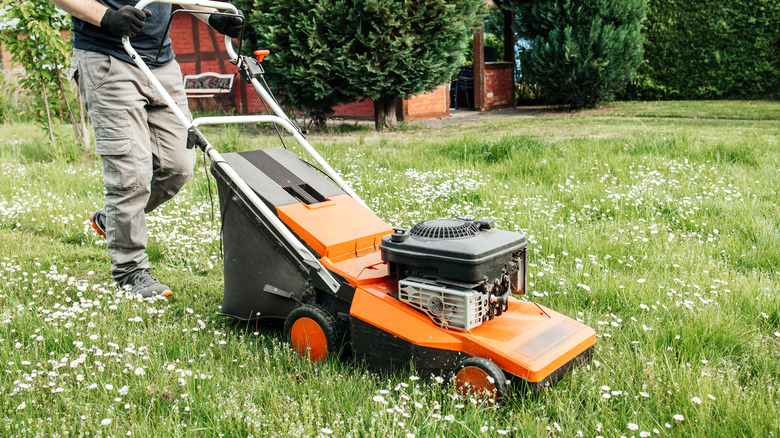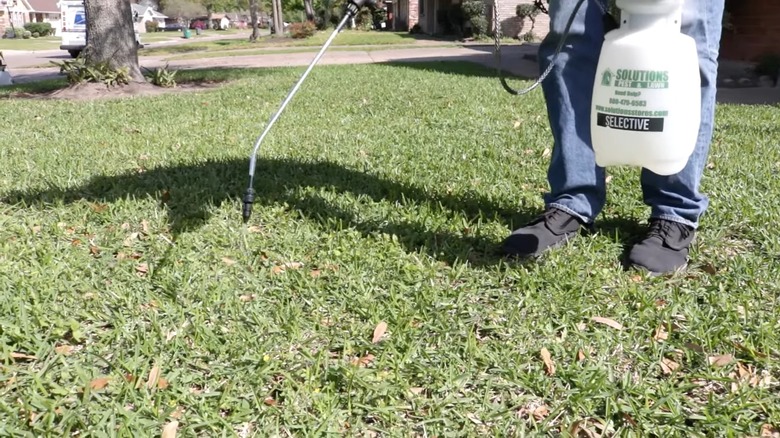The Best Methods To Prevent And Get Rid Of Virginia Buttonweed
We may receive a commission on purchases made from links.
Nothing puts a damper on lush, green lawn dreams like weeds — Virginia buttonweed (Diodia virginiana), in particular. It's unusually pernicious, spreading in dense, yellow-speckled (sometimes purple-edged) green patches that stand out pointedly against the established turf. While you might be tempted to allow the broadleaf weed some berth because of its pretty white flowers, it'd be a bad call since it chokes out the surrounding grass and leaves bare patches in its wake once the growth season is over. So, deny the invasive weed any space to root itself to keep your sunny lawn healthy and green. Mowing right and often, irrigating on a "need basis," aerifying the soil, redirecting foot traffic to encourage turf recovery, and timely resolution of lawn stressors and diseases are some measures to prevent Virginia buttonweed from taking over your yard.
However, in case Virginia buttonweed manages to establish itself on your turf, due to wind dispersal, hitch-hiking on lawn equipment, or via returned lawn clippings, the only way to get rid of it is by treating it with a post-emergent broadleaf herbicide. Remember, successive applications will be necessary to achieve effective control, given the multiple ways it can return to your yard, such as dormant seeds, rhizomes, and vegetative reproduction from stray plant segments.
Prevent Virginia buttonweed's establishment
Virginia buttonweed is especially problematic in the warm-season lawns of southeastern U.S. states, particularly around the Gulf Coast. These weeds institute themselves in constantly wet areas, birthed courtesy of overwatering, frequent rainfall, or poor drainage. That's why ensuring adequate water percolation and eliminating any standing water pools in your yard is amply important. Core aerification — when timed right — especially helps, both in reducing soil compaction and improving drainage. For instance, core aerifying warm-season grasses when they're actively growing but aren't under duress from droughts encourages their regrowth, denying weeds any fighting chance. But core aerating them early in the spring leaves them vulnerable to weed invasion, as they're still waking up from winter dormancy.
Righting your irrigation schedule is equally important. Develop the habit of watering the grasses deeply when they begin showing signs of water stress, or no earlier than once a week. This will encourage deeper rooting, keeping the turf competitive, and simultaneously make the conditions unfavorable for Virginia buttonweed. Take the time to resolve any issues in the drainage system. Another important consideration to prevent Virginia buttonweed's colonization is to raise the mowing height of your turf during active seasonal growth, so that it may shade out the invading weed. However, follow it up by raising mowing frequency, or else you might end up scalping the vigorously tall grasses, ridding the yard with balding patches where the prolific invasive can move in. Also, dethatch your lawn to rebuff any attempts at establishment.
Getting rid of Virginia buttonweed in your lawn
Although pulling out the offensive plants is one of the least harmful ways to kill weeds in your lawn, it's surprisingly ineffective against the perennial Virginia buttonweed. That's because it can vegetatively reproduce from any stem fragments or runners left behind in the soil — a common occurrence since it roots deeply. This is also why pre-emergent herbicides show subpar results in getting a hold of the nuisance weed. So, how to get rid of weeds in your yard? By spot-treating the Virginia buttonweed with post-emergence herbicides, preferably in spring right when they're sending out new runners, and repeating the applications as necessary through the summer.
Sulfonylurea herbicides like MSM Turf with metsulfuron as an active ingredient (available for under $25 on Amazon) provide decent control over small weed patches. But if that fails, combination herbicides or 3-way products combining dicamba, MCPP, and 2,4-D may come handy. Bayer's Celsius (retailing at Amazon for $20 for a single dose) is one such commercial-grade product. Read the label beforehand to nail the optimum diluted blend and verify if it's suitable for your turfgrass. For instance, Celsius shouldn't be used on tall fescue or centipede grass. Also, ensure you don't apply 2,4-D-containing products after the mercury soars past 85 degrees Fahrenheit to minimize turf damage (Metsulfuron products will remain safe, however). Depending on the infestation's severity (and the label instructions), repeat the application every four to six weeks.


